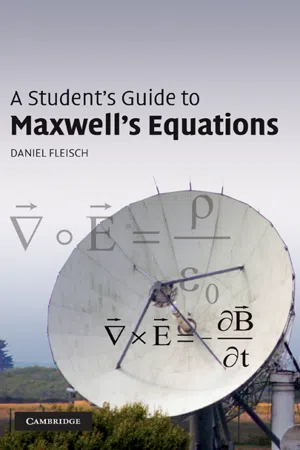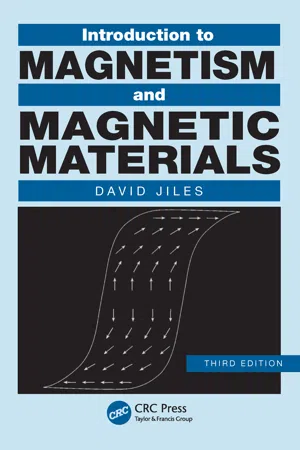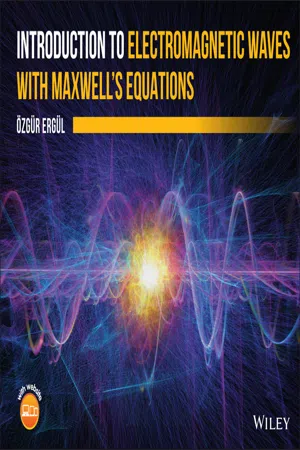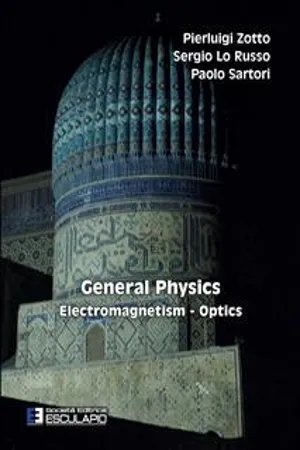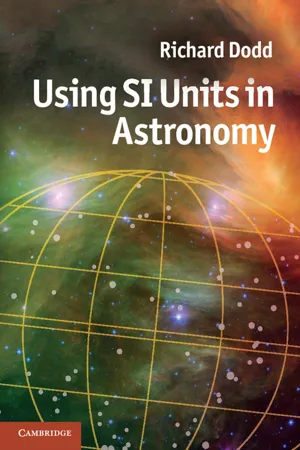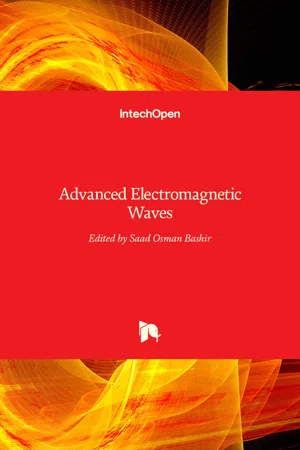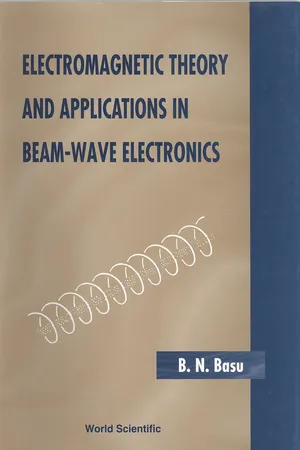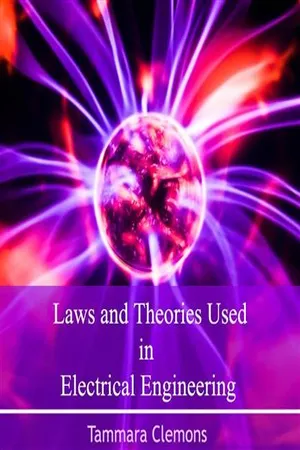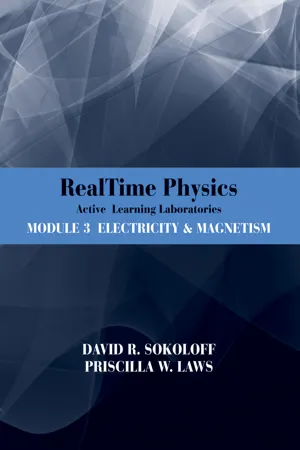Physics
Ampere's Law
Ampere's Law states that the magnetic field around a closed loop is directly proportional to the current passing through the loop. It provides a mathematical relationship between the magnetic field and the electric current that produces it, similar to how Gauss's Law relates electric fields to electric charges. Ampere's Law is a fundamental principle in the study of electromagnetism.
Written by Perlego with AI-assistance
Related key terms
1 of 5
11 Key excerpts on "Ampere's Law"
- eBook - PDF
- Daniel Fleisch(Author)
- 2008(Publication Date)
- Cambridge University Press(Publisher)
4 The Ampere–Maxwell law For thousands of years, the only known sources of magnetic fields were certain iron ores and other materials that had been accidentally or deliberately magnetized. Then in 1820, French physicist Andre-Marie Ampere heard that in Denmark Hans Christian Oersted had deflected a compass needle by passing an electric current nearby, and within one week Ampere had begun quantifying the relationship between electric currents and magnetic fields. ‘‘Ampere’s law’’ relating a steady electric current to a circulating magnetic field was well known by the time James Clerk Maxwell began his work in the field in the 1850s. However, Ampere’s law was known to apply only to static situations involving steady currents. It was Maxwell’s addition of another source term – a changing electric flux – that extended the applicability of Ampere’s law to time-dependent conditions. More importantly, it was the presence of this term in the equation now called the Ampere–Maxwell law that allowed Maxwell to discern the electro-magnetic nature of light and to develop a comprehensive theory of electromagnetism. 4.1 The integral form of the Ampere–Maxwell law The integral form of the Ampere–Maxwell law is generally written as I C ~ B d ~ l ¼ l 0 I enc þ e 0 d dt Z S ~ E ^ n da The Ampere – Maxwell law : The left side of this equation is a mathematical description of the circulation of the magnetic field around a closed path C . The right side 83 includes two sources for the magnetic field; a steady conduction current and a changing electric flux through any surface S bounded by path C . In this chapter, you’ll find a discussion of the circulation of the mag-netic field, a description of how to determine which current to include in calculating ~ B , and an explanation of why the changing electric flux is called the ‘‘displacement current.’’ There are also examples of how to use the Ampere–Maxwell law to solve problems involving currents and magnetic fields. - David Jiles(Author)
- 2015(Publication Date)
- CRC Press(Publisher)
459 Solutions to Exercises CHAPTER 1 E XERCISE 1.1: D EFINITION OF A MPERE The ampere is defined as the current that, when passed along two infinite conduc-tors lying parallel to each other 1 m apart, gives rise to a force per unit length of 2 × 10 − 7 N m − 1 . From Ampère’s circuital law, the magnetic field H at a radial distance a from a long conductor carrying current i is H = i a 2 1 π A m -Therefore, the field at a distance of 1 m from a long linear conductor carrying a current of 1 A is H = -1 2 1 π A m The force per unit length, F / l , on a current-carrying conductor with current i caused by a perpendicular magnetic induction B is F l i = B and in this case F / l = 2 × 10 − 7 N m − 1 , and i = 1 A. Therefore, B = × 2 10 7 -T Now since by definition B = μ 0 H , then the magnetic induction of 2 × 10 − 7 T corre-sponds to a magnetic field in free space of 1/2 π A m − 1 , and so μ π 0 7 1 4 10 = = × B H --H m E XERCISE 1.2: D IFFERENCE BETWEEN H AND B An essay on the difference between B and H should concentrate on the two Maxwell equations, which relate to these quantities: 460 Solutions to Exercises ∇× = + ∂ ∂ ∇× = -∂ ∂ H t t J D E B or equivalently the Ampère circuital law for H , H ⋅ = ∫ dl Ni or its Biot-Savart law form dH i d l r = × 1 4 2 π ˆ r and the Faraday-Lenz law of induction for B , V NA d dt = -B and the Ampère force law (Ampère’s other law) in its various forms F B m B B = × = × = × i dl qv the last of these also being known as the Lorentz force law , although it is essentially just the Ampère force law in a slightly different form. A field strength of 1 A m − 1 is generated at the center of a circular coil of conductor of diameter 1 m when it carries a current of 1 A. A magnetic induction of 1 T generates a force of 1 N m − 1 on a conductor carrying a current of 1 A perpendicular to the direction of the induction. The main difference between these quantities is then clear.- eBook - PDF
Electromagnetism for Engineers
An Introductory Course
- P. Hammond(Author)
- 2013(Publication Date)
- Pergamon(Publisher)
It was known that thunderstorms sometimes interfered with magnetic measurements at sea, but apart from this there seemed to be little connection between the two phenomena. There was of course the mathematical link of the inverse square law but that might have had no physical significance. This was the state of the subject until 1820. In that year the Danish philosopher Oersted made a startling discovery which altered everything. Oersted discovered that a magnetic compass needle was deflected in the neighbourhood of an electric current. Thus there were not only forces between charges and forces between magnets, but also forces between moving charges and magnets. The two subjects of electricity and magnetism had come together, the science of electromagnetism was born. Scientists everywhere realized the crucial nature of Oersted's experiment and studied its implications. Foremost amongst them was Ampere, who within 3 months of hearing the news had developed a complete theory of the interaction of electric currents and magnets and of the action of electric currents upon one another. Ampere carried out a series of brilliant experiments and also developed a mathematical theory. The work earned for him the title of the Newton of electricity. He found out, amongst other things, that parallel currents attract if they flow in the same direction and repel if they flow in opposite directions. His discoveries can be summarized in the first law of electromagnetism: The magnetic field of a small current loop is at a distance identical with the magnetic field of a small magnet. The product of the current and the area of the loop is proportional to the moment of the magnet, i.e. to the product of pole strength and distance between the poles. The direction of the current is related to the magnet in such a manner that if the current flows anticlockwise the nearer pole is a north pole and if the current flows clockwise the nearer pole is a south pole. - Ozgur Ergul(Author)
- 2021(Publication Date)
- Wiley(Publisher)
(2.339) In other words, we are able to use Ampere’s law for the magnetic flux density, while we cannot place the permeability outside the derivative (curl operation). In such a case, the derivative of the permeability (its gradient) may be used to write the complete and correct equation for ¯ ∇ × ¯ B m (¯ r, t ). We may now construct the mathematical basis for the interaction of magnetic fields with magnetic materials, particularly in the context of Ampere’s law. As usual, we list the tools and concepts for this purpose: • Magnetic dipole • Magnetization • Equivalent magnetization currents These are in addition to previous tools: differential length with direction (Section 2.1.1 ), cross product (Section 2.3.2 ), circulation of vector fields (Section 2.1.2 ), electric current den-sity (Section 2.3.1 ), curl of vector fields (Section 2.3.3 ), and Stokes’ theorem (Section 2.3.4 ). Also, we need to know differential surface with direction (Section 1.1.1 ), dot prod-uct (Section 1.1.2 ), and flux of vector fields (Section 1.1.3 ). 2.8.1 Magnetic Dipole As opposed to the existence of electric charges, there is no magnetic charge in nature (Figure 2.80 ). On the other hand, a magnetic dipole, which creates a magnetic field that is similar 82 to the electric field created by an electric dipole, can be defined as a 82 This similarity is particularly for the far zone: i.e. away from the dipole. circular loop carrying a constant electric current (Figure 2.81 ). Consider a steady I 0 flowing Ampere’s law 133 along a loop of radius a located at the origin in a vacuum. The magnetic field intensity at an arbitrary location ¯ r can be found as B -Figure 2.82 Magnetic field lines for a magnetic dipole. Magnetic dipoles are very useful to describe various phenomena, such as magnetization.- eBook - PDF
- Pierluigi Zotto, Sergio Lo Russo, Paolo Sartori(Authors)
- 2022(Publication Date)
- Società Editrice Esculapio(Publisher)
For instance, by following these prescriptions, the application of Ampère’s theorem to the system shown in the figure provides Bid r γ ∫ = μ 0 i 1 − 2i 3 − i 4 ( ) . The hypothesis that currents must be steady, used while dem- onstrating the theorem, implies that currents must be direct cur- rents which therefore must flow in closed circuits. Hence, the validity of Ampère’s theorem is limited to static magnetic fields and it must be necessarily modified in order to cope with magnetic fields generated by time dependent currents, i.e. time dependent magnetic fields (see paragraph 14.2). γ i 1 > 0 i 4 < 0 does not contribute contributes twice 2i 3 < 0 i 2 Laws of Magnetostatics Chapter 10 164 † The demonstration of Ampère’s theorem requires the application to a circuit of whatever shape of the dipole field presented in the footnote in paragraph 10.3 and it is omitted. It is however relevant to remark that the fundamental assumption in order to perform the demonstration is that all the cur- rents linked to line γ are time independent. A partial argument, justifying this assumption, is given as a note at the end of this paragraph in the case of an indefinite wire. 10.8 Applications of Ampère’s Law Ampère’s law allows the calculation of a magnetic field when the symmetries of a sys- tem can be exploited. The closed loop γ used in order to compute the circulation must be carefully chosen to ensure that the scalar product which appears as argument of the integral on the left side of Ampère’s law expression can be easily evaluated along the whole loop. Chapter 10 Laws of Magnetostatics 165 Note Magnetic Field Circulation of an Indefinite Wire This note discusses the comparison between the circulation of the magnetic field gener- ated by an indefinite wire along an amperian loop linking the wire and a closed loop which does not link it. Any chosen closed loop γ must be oriented counterclockwise. - eBook - PDF
- Richard Dodd(Author)
- 2011(Publication Date)
- Cambridge University Press(Publisher)
10 Unit of electric current (ampere) 10.1 SI definition of the ampere The ampere is that constant current which, if maintained in two straight parallel conductors of infinite length, of negligible cross section, and placed 1 metre apart in vacuum, would produce between these conductors a force equal to 2 × 10 −7 newton per metre of length. The dimension of electric current is [I ], its unit is the ampere and its symbol is A. 10.1.1 Possible future definition of the ampere Under discussion at the present time is the redefining of the unit of electric current in the following way: The ampere is a unit of electric current such that the elementary charge is exactly 1.602 176 53 × 10 −19 C, where 1 C (coulomb) = 1A. s (ampere second). 10.1.2 Definition of electricity Funk & Wagnalls New Standard Dictionary of the English Language (1946) gives a general definition of electricity as: Electricity: A material agency which, when in motion, exhibits magnetic, chemical and thermal effects, and which, whether in motion or at rest, is of such a nature that when it is present in two or more localities within certain limits of association, a mutual interaction of force between such localities is observed. And as a physics-related definition of electricity: That branch of science that treats of this agency and the phenomena caused by it. 174 10.2 SI and non-SI electrical and magnetic unit relationships 175 10.1.3 Definition of magnetism Funk et al.(1946) give, as a general definition of magnetism: Magnetism: that quality or agency by virtue of which certain bodies are productive of magnetic force or susceptible to its action. And as a physics-related defintion of magnetism: The science that treats the laws and conditions of magnetic force. - eBook - PDF
- Saad Osman Bashir(Author)
- 2015(Publication Date)
- IntechOpen(Publisher)
Chapter 3 The Electromagnetic Force between Two Parallel Current Conductors Explained Using Coulomb’s Law Jan Olof Jonson Additional information is available at the end of the chapter http://dx.doi.org/10.5772/61221 Abstract In this book chapter the electromagnetic force between two parallel electric conduc‐ tors has been derived, applying thereby the effects of propagation delay and the Spe‐ cial Relativity theory, taking thereby also into count the thus far neglected effects introduced by the voltage sources of both circuits. This has been done for a specific case consisting of two rectangular circuits, aligned to each other along one of the long sides, at a distance that is short compared to the long sides. The intention in doing so is to make a meaningful application of the concept of “two parallel conductors of in‐ finite length”, so that it is possible to make a complete calculation of the force between the two circuits, avoiding thus making a vague claim as for example Maxwell, saying that the other parts of the conductors do not contribute to the force. What is radically new in this interpretation is that it is Coulomb’s law that is responsible for the force. Keywords: Ampère’s Bridge, Ampère’s Law, Coulomb’s Law, electromagnetic force, Lorentz force, Lorentz transformation, parallel conductors, propagation delay, retard‐ ed action, Special Relativity theory, Sagnac effect, time dilatation 1. Introduction In several papers evidence has been presented that is able to refute the widely recognized electromagnetic theory of today [1-5]. One such fundamental law is Lorentz’ force law. Already 1997 a paper presented mathematical proofs showing that this law is unable to explain the repulsive force between collinear currents, demonstrated in the case of Ampère’s bridge [1]. Even Graneau’s exploding wires and Hering’s pump cause difficulties, when trying to use Lorentz’ force law in order to explain the effects that have been registered [6-11]. - B N Basu(Author)
- 1996(Publication Date)
- World Scientific(Publisher)
(4.3.13) 4.3.1 Differential Form of Faraday's Law If we compare Faraday's law, given by (4.3.13), with Ampere's circuital law, given by (3.2.15), we will find a similarly in their forms. In fact, if we replace H by E, and also J by -'dB/dt in the latter, we shall immediately get the former. It then follows that, by following the same procedure as given in section 3.2.3, one should arrive at the differential 108 Time Varying Electric and Magnetic Field Ch.4 or point form of Faraday's law from its integral form. Thus if we now again replace H by E, and J by - 5B/dt, in (3.2.17), we shall have the following differential or point form: SB VxE = -— (Faraday's law). (4.3.14) Thus, Faraday's law, (4.3.13) or (4.3.14), gives a quantitative estimate of the electric field caused by a time-varying magnetic field. Simultaneously with Faraday's law is named another law called Lenz's law according to which the direction of the current due to electromagnetic induction will be such that the effect of this induced current opposes the cause to which it is due. The minus sign in Faraday's law in various forms: (4.3.6) and (4.3.11)-(4.3.14), in fact, certifies to Lenz's law. This point will be further clear referring back to the setup of Fig. 4.3.1 (and to a few examples to follow). In the setup of Fig. 4.3.1, i^ has a negative x direction (see the discussion following (4.3.6)). Accordingly, the force on AiA 2 due to ii„d will be - ii„d 1 a x x B a y = - ijnd 1 B a z which has a direction opposite to what is given by (4.3.1). Thus the induced current opposes the causes to which it is due. Example 4.3.1 Obtain the direction of the induced current in the circuit of Fig.- No longer available |Learn more
- (Author)
- 2014(Publication Date)
- Academic Studio(Publisher)
Faraday's law as two different phenomena Some physicists have remarked that Faraday's law is a single equation describing two different phenomena: The motional EMF generated by a magnetic force on a moving wire, and the transformer EMF generated by an electric force due to a changing magnetic field. James Clerk Maxwell drew attention to this fact in his 1861 paper On Physical Lines of Force . In the latter half of part II of that paper, Maxwell gives a separate physical explanation for each of the two phenomena. A reference to these two aspects of electromagnetic induction is made in some modern textbooks. As Richard Feynman states: So the flux rule that the emf in a circuit is equal to the rate of change of the magnetic flux through the circuit applies whether the flux changes because the field changes or because the circuit moves (or both) .... Yet in our explanation of the rule we have used two completely– distinct laws for the two cases for circuit moves and for field changes. ________________________ WORLD TECHNOLOGIES ________________________ We know of no other place in physics where such a simple and accurate general principle requires for its real understanding an analysis in terms of two different phenomena . – Richard P. Feynman , The Feynman Lectures on Physics Reflection on this apparent dichotomy was one of the principal paths that led Einstein to develop special relativity: It is known that Maxwell’s electrodynamics—as usually understood at the present time— when applied to moving bodies, leads to asymmetries which do not appear to be inherent in the phenomena. Take, for example, the reciprocal electrodynamic action of a magnet and a conductor. The observable phenomenon here depends only on the relative motion of the conductor and the magnet, whereas the customary view draws a sharp distinction between the two cases in which either the one or the other of these bodies is in motion. - No longer available |Learn more
- (Author)
- 2014(Publication Date)
- University Publications(Publisher)
Faraday's law as two different phenomena Some physicists have remarked that Faraday's law is a single equation describing two different phenomena: The motional EMF generated by a magnetic force on a moving wire, and the transformer EMF generated by an electric force due to a changing magnetic field. James Clerk Maxwell drew attention to this fact in his 1861 paper On Physical Lines of Force . In the latter half of part II of that paper, Maxwell gives a separate physical explanation for each of the two phenomena. A reference to these two aspects of electromagnetic induction is made in some modern textbooks. As Richard Feynman states: ____________________ WORLD TECHNOLOGIES ____________________ So the flux rule that the emf in a circuit is equal to the rate of change of the magnetic flux through the circuit applies whether the flux changes because the field changes or because the circuit moves (or both) .... Yet in our explanation of the rule we have used two completely – distinct laws for the two cases for circuit moves and for field changes. We know of no other place in physics where such a simple and accurate general principle requires for its real understanding an analysis in terms of two different phenomena . – Richard P. Feynman , The Feynman Lectures on Physics Reflection on this apparent dichotomy was one of the principal paths that led Einstein to develop special relativity: It is known that Maxwell’s electrodynamics—as usually understood at the present time— when applied to moving bodies, leads to asymmetries which do not appear to be inherent in the phenomena. Take, for example, the reciprocal electrodynamic action of a magnet and a conductor. The observable phenomenon here depends only on the relative motion of the conductor and the magnet, whereas the customary view draws a sharp distinction between the two cases in which either the one or the other of these bodies is in motion. - eBook - PDF
RealTime Physics: Active Learning Laboratories, Module 3
Electricity and Magnetism
- David R. Sokoloff, Priscilla W. Laws(Authors)
- 2012(Publication Date)
- Wiley(Publisher)
Thus, if a 194 REALTIME PHYSICS: ELECTRICITY AND MAGNETISM magnet exerts a force on a current-carrying wire, shouldn’t the wire exert an equal and opposite force back on the magnet? It is not unreasonable to speculate that currents and moving charges exert these forces by producing magnetic fields them- selves. One of the agendas for this lab is to investigate the possibility that an elec- tric current can produce a magnetic field. This line of argument based on Newton’s Third law and its symmetry can lead us into even deeper speculation. If charges have electric fields associated with them, then moving charges can be represented mathematically by changing elec- tric fields. Thus, we can say that changing electric fields are the cause of magnetic fields. This leads inevitably to the following question: If this is so, then, by sym- metry, can changing magnetic fields cause electric fields? You will explore three phenomena in this lab: (1) The nature of the magnetic field produced by a long straight current-carrying wire; (2) Faraday’s law of elec- tromagnetic induction that describes how changing magnetic fields produce elec- tric fields, emfs and currents; and (3) Lenz’s law that describes the sense or direc- tion of the emfs and currents produced by electromagnetic induction. Faraday’s law lies at the heart of the study of electricity and magnetism, and electromagnetic induction is the basis for the production of the electric power on which we depend. INVESTIGATION 1: MAGNETISM FROM ELECTRICITY The Magnetic Field Near a Current-Carrying Wire In 1819 during a lecture demonstration a Danish physicist, H.C. Oersted, placed a current carrying wire near a compass needle. Although Oersted predicted that the current would cause a force to be exerted on the compass needle, the details of the result surprised him.
Index pages curate the most relevant extracts from our library of academic textbooks. They’ve been created using an in-house natural language model (NLM), each adding context and meaning to key research topics.
